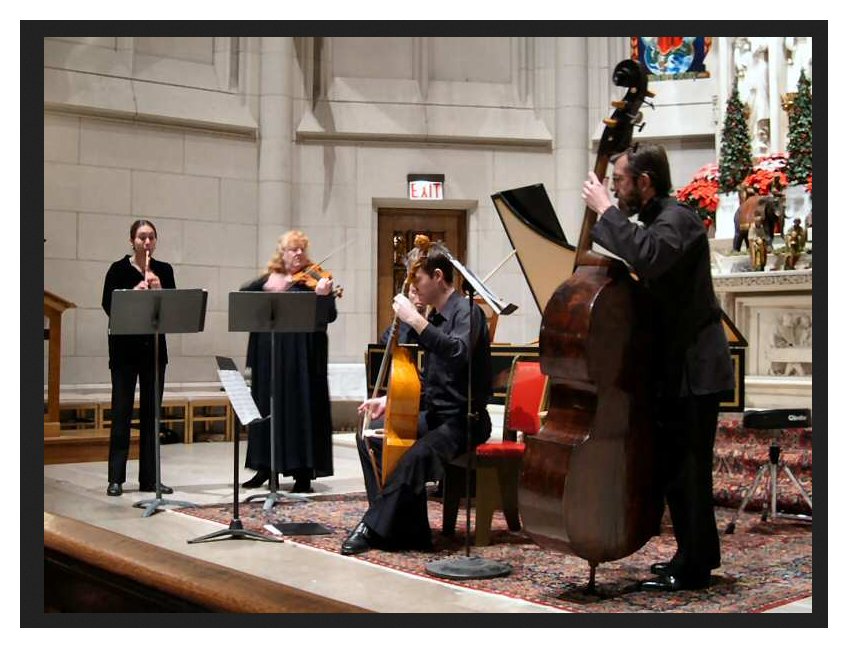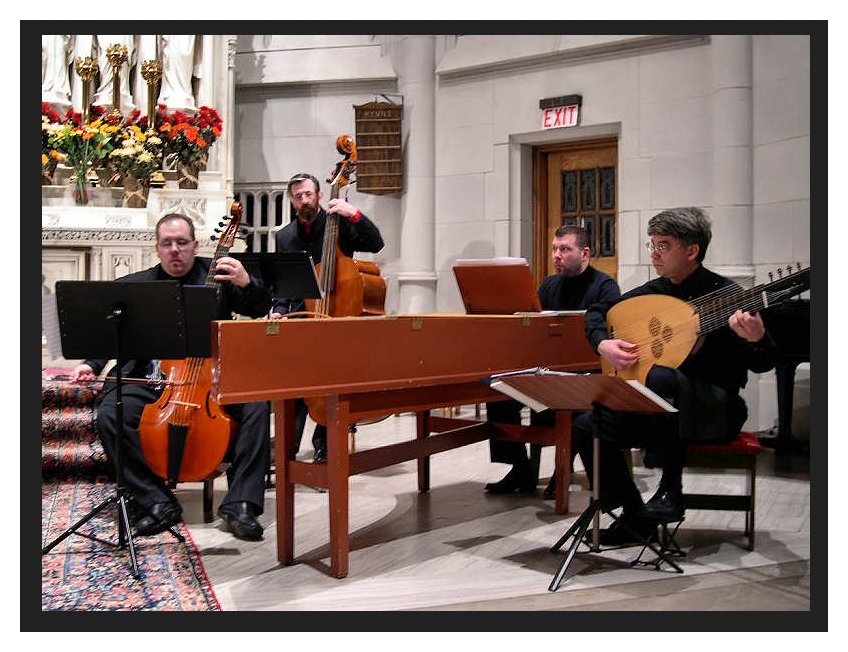Jerry Fuller
Performer and Scholar of the
Double Bass and Violone
A conversation with Bruce Duffie
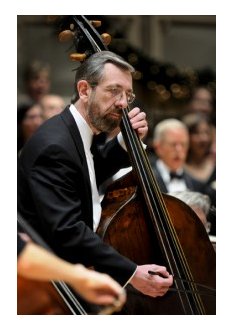 Jerry Fuller began studying the double bass at age 16 and was invited to
join the Lyric Opera of Chicago orchestra three years later. Within two years
he was promoted to first desk of the double bass section in addition to performing
with the Santa Fe Opera. Mr Fuller has also served as solo double bass of
The Musikkollegium Winterthur Switzerland. While in Europe, Mr. Fuller became
interested in historically-informed performance practice and has achieved
international recognition for his work with period instruments. A Chicago
Artists Abroad grant recipient, Mr.Fuller’s performances in London, Rome,
Geneva and Edinburgh have been broadcast worldwide. In addition, Mr. Fuller
has performed at the Ravinia and the Aspen Music Festivals and both the Boston
and Berkeley Early Music Festivals.
Jerry Fuller began studying the double bass at age 16 and was invited to
join the Lyric Opera of Chicago orchestra three years later. Within two years
he was promoted to first desk of the double bass section in addition to performing
with the Santa Fe Opera. Mr Fuller has also served as solo double bass of
The Musikkollegium Winterthur Switzerland. While in Europe, Mr. Fuller became
interested in historically-informed performance practice and has achieved
international recognition for his work with period instruments. A Chicago
Artists Abroad grant recipient, Mr.Fuller’s performances in London, Rome,
Geneva and Edinburgh have been broadcast worldwide. In addition, Mr. Fuller
has performed at the Ravinia and the Aspen Music Festivals and both the Boston
and Berkeley Early Music Festivals.
His recordings on the Musical Arts Society, Cedille and Centaur labels have
been hailed by both critics and colleagues. Mr. Fuller also writes on period
instruments and performance practice for The Strad, Double Bassist, and Bass World magazines, serves on the editorial
board of the Online Journal of Bass Research
and is webmaster for the Double Bass and
Violone Internet Archive.
Mr. Fuller served as an officer of the Board of Directors of the International
Society of Bassists 1990-1996 and has appeared as a guest artist with the
American Bach Soloists of San Francisco, the Handel and Haydn Society of
Boston and the Newberry Consort of Chicago.
He is principal double bassist of the Haymarket Opera, Callipygian Players
and The Bach Institute at Valparaiso University. In addition he is Director
of both ArsAntiguaPresents.com and the Midwest Young Artists Early Music
Program for which he was awarded the Early Music America Outreach Award for
Excellence in Early Music Education.
Jerry also has received a Special Recognition Award for Historically Informed
Performance from the International Society of Bassists. This award is given
once every two years to a bassist who has demonstrated and achieved the highest
level of excellence in historically informed performance.
-- From the Ars Antigua Website.
Ars Antigua is an affiliate of Early Music America and member of Early Music
Chicago.
|
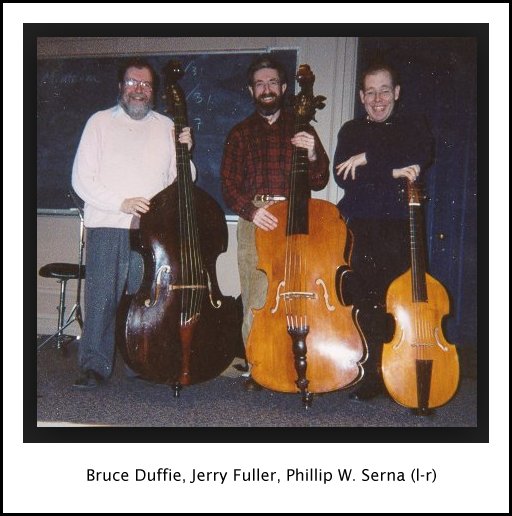 In the name of full disclosure, I am happy
to report that Jerry Fuller is a long-standing friend of mine... and it was
not until I just typed that sentence that I realized the phrase ‘long-standing’
also applies to his position with his chosen instruments! Indeed, we
talk about that later in the interview.
In the name of full disclosure, I am happy
to report that Jerry Fuller is a long-standing friend of mine... and it was
not until I just typed that sentence that I realized the phrase ‘long-standing’
also applies to his position with his chosen instruments! Indeed, we
talk about that later in the interview.
We have stayed in touch over the years, and have many friends in common.
We also have a mutual interest in Northwestern University, and while I was
teaching there (2002-11), I asked Jerry to come and do an instrumental demonstration
for my Music 101 class. He
brought another friend with him, the gambist Phillip W. Serna, as well as
a third instrument, as can be seen in the photo of all of us at right.
[Serna also appears in the final photo at the bottom of this webpage.]
No stranger, himself, to teaching, the next photo below shows Fuller giving
a demonstration and workshop for the Midwest Young Artists in Lake Forest,
IL, in 2006. The other photos on this page show Fuller in performances
at various venues with Ars Antiqua, the Baroque Band, and the Callipygian
Players.
In the spring of 1997, I wanted to present a special program featuring his
recordings and comments on WNIB, Classical 97, where I was announcer/producer
from 1975-2001. He liked the idea, so we got together at his home that
June for this conversation.
I began with what seemed to be an obvious question . . . . . . . . .
Bruce Duffie: Why
the double bass?
Jerry Fuller: I
remember when I was sixteen years old, going to a concert in my little hometown
in Beaver Dam, Wisconsin, where the Milwaukee Symphony was playing a concert
at Wayland Academy. My parents saw them there regularly. My father
had played the violin in his youth, though I had never witnessed either of
them performing on a musical instrument. I was intrigued, and still
remember the concert very well. The big work was Tchaikovsky’s Fourth Symphony. It was totally
random, but for some reason I was placed in front of the double bass section,
and as I observed all of this, the bass clearly seemed to be having the best
time of any group in the orchestra. And the sound was just phenomenal
to my ears! At intermission I went up and talked to Roger Ruggeri,
the principal bass then and who is still principal bass there. He is
a very fine player.
BD: You had not
played violin or trumpet before this?
JF: No, no.
A little bit of piano, but really nothing. It was like a thunder bolt
that struck me, so I asked him at intermission, “I’d love to take lessons
on the double bass. Who could I do this with? He said, “In this
little town I’m not sure what you’re going to do.” But in Madison,
Wisconsin, there was a very fine teacher, Vera Olson, and he suggested that
I contact her. So I did that and then I made the trip to Madison, which
was a bus ride away, every Saturday, and started taking lessons.
BD: Being sixteen,
though, you were tall enough so you could handle the instrument?
JF: Exactly, right.
The world has evolved and progressed, in one sense, in the intervening time.
It was typical back in the late 1960s and early 1970s that one would wait
until they were in high school, or large enough to get their hands around
this instrument. Now there are programs all around the world for young
students, seven, eight, nine years old, to play on half-size and smaller
double basses. There are makers out there today that are making those
instruments, and there are wonderfully dedicated teachers that are teaching
very young students, and getting them started much earlier on the bass.
BD: Is it better
to start on the double bass, or to start on the violin and transfer to the
double bass? Or maybe start on the cello and transfer to the double
bass?
JF: I’m biased.
I think going right to the double bass is a wonderful thing to do, especially
with the instruments that are available now and the fine teachers that are
available now. Go right to the instrument and learn that literature
and the techniques and the unique sounds, and everything that’s special about
the double bass right from the beginning.
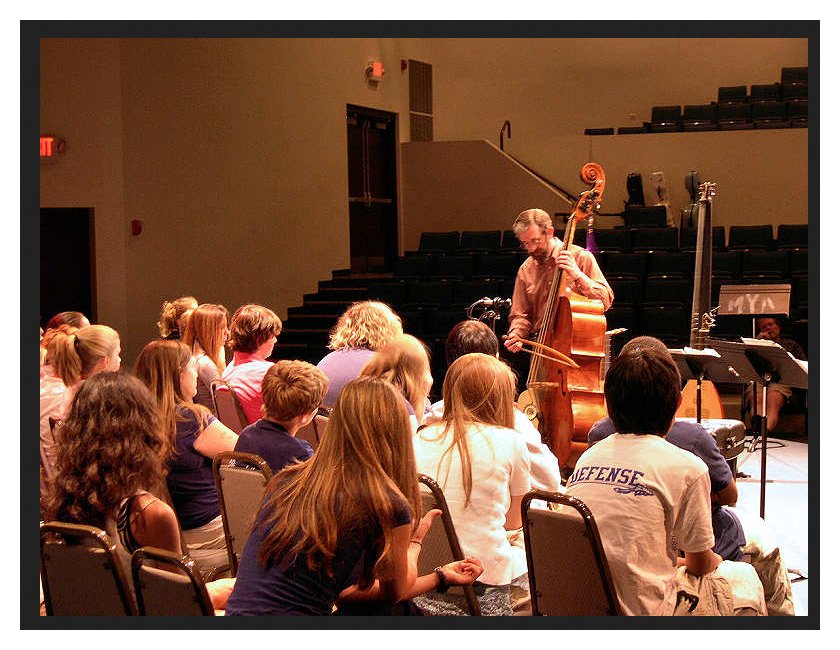
BD: Does it still
surprise people that it can be a solo instrument?
JF: Yes, but less
so. It’s interesting. The year I started, Gary Karr put out his very
first recording, a wonderful recording, but prior to that there were maybe
one or two recordings available that featured the double bass at all.
I remember after my second or third lesson in Madison, going into the local
record store and finding a recording by Georg Hörtnagel, from Germany,
doing Dittersdorf’s Concerto and
Sinfonia Concertante with viola.
That was all there was! It was a marvelous sound, a marvelous recording,
and then the famous Gary Karr recording came out, which everybody knows.
Now there are pages and pages and pages of CDs and recordings in the catalogue,
so that has contributed enormously to the visibility of the double bass,
and to people’s awareness.
BD: [With a gentle
nudge] I hardly think the double bass is something that can be invisible.
[Both laugh]
JF: That’s true.
BD: Are there times
when you wish you’d taken up the piccolo?
JF: Only on long
plane rides. I’ll never forget... I was traveling to Rome with William Ferris, the Chicago
composer who had written a marvelous piece for tenor, harp, and double bass,
which we were going to perform at the Vatican. [This, along with
another Ferris piece, were recorded, and the CD is shown near the bottom-right
on this webpage. The tenor soloist is John Vorrasi.] I
got on the plane with the double bass, and sat it in the seat next to me.
BD: Did you have
to buy a ticket for it?
JF: Oh absolutely!
There was an older Italian lady who did not speak English at all, but certainly
got her point across about what she thought of having a double bass sitting
next to her. [Both laugh again]
BD: Not very happy,
was she?
JF: No. It
can be a little bit tense times, but there are benefits. You always
get an extra meal on the flight...
* *
* * *
BD: You not only
play the standard double bass, but you also play a baroque instrument of
that size?
JF: Yes.
As the years went along, I’ve acquired an interest in musical genealogy,
if you will. One of the ancestors, or the ancestor, to the double bass
is an instrument called the violone. It’s a fascinating world to me,
and the terminology is a little bit complex, in the sense that this one term
‘violone’ really refers to at
least three slightly different instruments. The earliest known reference
to the violone was in the mid-1500s, the mid-16th century, and in fact I
have a reproduction of an instrument that’s now in the Nuremberg museum.
It’s a contrabbasso violone in the sixteen foot register, the same register
as a double bass, but it is a six-stringed fretted instrument that’s tuned
an octave below the viola da gamba, the bass viola da gamba. So it’s
a D to D tuning. That instrument was widely used in that era between
1550 and, say, 1700. By 1680 it was starting to fall out of use.
BD: Are the strings
tuned in fourths like in the double bass?
JF: Fourths and
thirds like a viola da gamba, which is interesting. If you look at
the modern orchestra today, the violin family is violin, viola, cello, and
their ancestors were always of the violin family. There’s this myth
that circulates every now and then that their ancestors were really the gambas,
but they’re really a separate family. The gamba family is a separate
family, but the modern double bass grew out of the gamba family, whereas
the modern other stringed instruments really grew out of the violin family,
and evolved from there. [For a further discussion of the gamba,
see my interview with gambist Mary Springfels.]
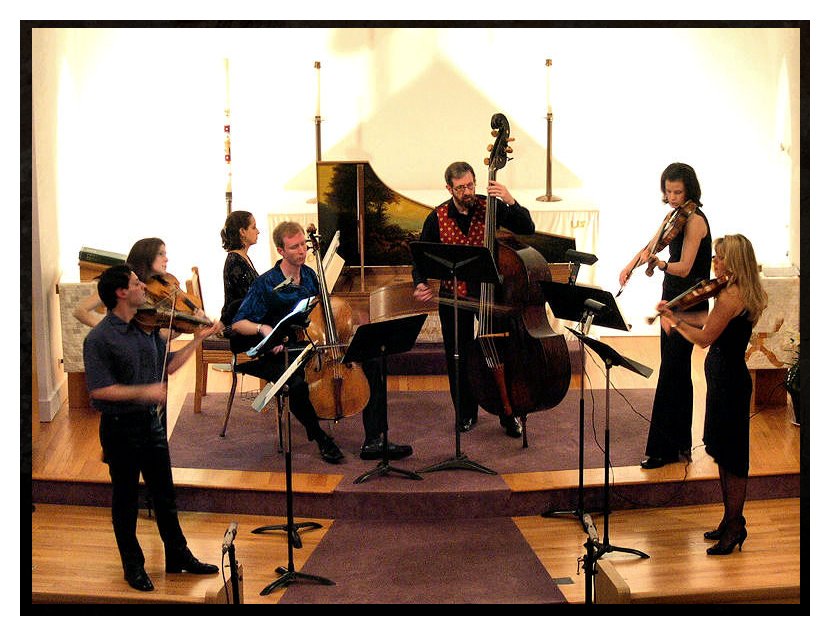
BD: When you’re
playing the double bass, though, you have the strings tuned in fourths?
JF: In fourths.
BD: And it has
no frets?
JF: That’s correct.
BD: So it’s a completely
different fingering of the left hand?
JF: Yes, they are
different tunings. The D-tuned violone contrabbasso is a different
tuning, and it’s a wonderful tuning for low consort music of the German and
Italian repertoire.
BD: So you have
to go back and forth between those two, the old and the new?
JF: Yes, yes, yes.
BD: Does that make
you schizophrenic at all?
JF: [Laughs]
Well... there’s some question whether I was that way before these two instruments
or not... but it takes a little bit of you getting used to. The more
one does it, the more facile one comes to do this. But there is a little
bit of that. So that’s one member of the violone family. There’s
another instrument that was in use at the time that’s also known as the violone,
and it’s a G violone. It’s a violone da gamba and it’s tuned a fourth
lower than the bass viola da gamba.
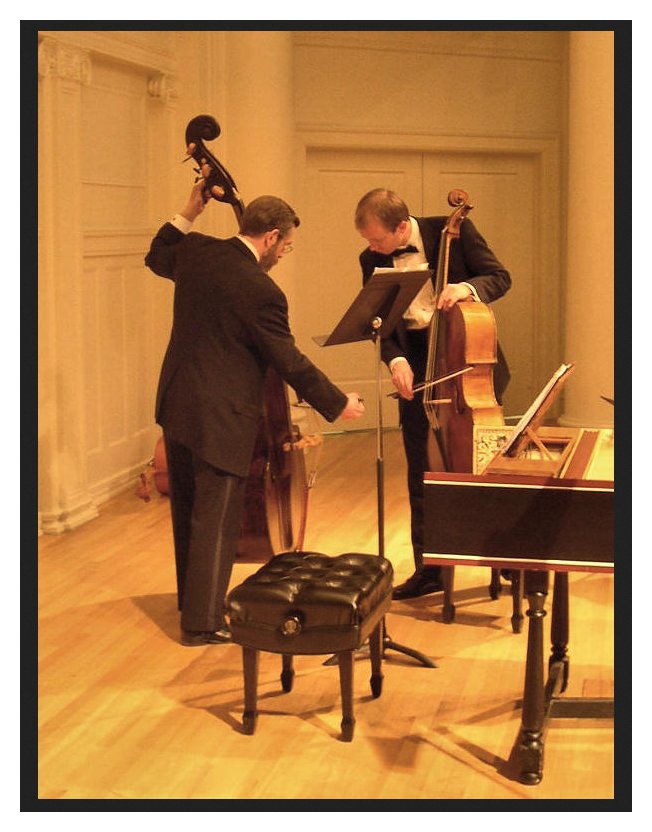 BD:
Is it written at pitch or is it a transposing instrument?
BD:
Is it written at pitch or is it a transposing instrument?
JF: It’s written
at pitch. It’s not a transposing instrument, as the double bass is,
one octave down, and as is the violone contrabbasso is, one octave down as
well. When you read it on a G violone, it is at pitch. So the
top four strings are tuned G, D, A, F or E, depending on which source you
look at, but very similar to a double bass, only an octave higher.
Then there are two more strings, a C and a G, so it starts getting you into
that sixteen foot register as well. This is a marvelous chamber music
instrument, and was most widely used before the steel strings or the wound
string for the cello, which were invented around 1680. This violone
da gamba was really used as the main bass or continuo instrument prior to
that time. Then there’s more. In terms of violone in the late
1700s and early 1800s, there’s something called the Viennese violone, which
was a five stringed instrument. From top to bottom it would go A, F-sharp,
D, A, F-natural, in the sixteen foot register. In this very short period
in terms of history, only twenty-five years or so, a huge golden age of solo
repertoire for the Viennese violone grew up with those people. In fact,
Mozart wrote a concert aria Per Questa
Bella Mano for baritone and violone.
BD: Where does
Dragonetti fit into all of this?
JF: He was slightly
later, and he was playing on an instrument that was tuned one of two ways
— the way a modern double bass is, G to A, or he was known, at
times, to perform on a three stringed instrument, G, D, G. So you can
see the history of this instrument is one of great creativity and experimentation.
BD: Has it settled
down now to where there is a standard double bass?
JF: Relatively,
compared to the terms we’ve been talking in, yes. It tends to be a
four stringed instrument, G, D, A, E from top to bottom, and tuned in fourths.
However, compared to the violin, it’s interesting. When you talk to
orchestral musicians about auditions, if they hear a violinist play and then
they hear a bass audition, they are always amazed at the different approaches,
styles, ways of tuning, that the double basses still have relative to a violin.
If someone’s playing a Tchaikovsky violin concerto, it’s a big deal whether
they move over one string or not. It’s a very standardized repertoire
pedagogically, and in the approach to the instrument. This certainly
is not true today for the double bass. I just returned from a trip
to Paris, where I was just amazed. We heard a marvelous performance
of Carmen at the Opera Bastille,
and the bass section played exactly alike. Their instruments were all
of similar shape and similar make. They all played with a French bow
and they all had a similar sound. When you come to a symphony orchestra
or opera orchestra here in the United States, one person’s playing a German
bow, another’s using a French bow, and their basses are of all different
sizes. Some have five strings on them. Most have four with low
C extensions, and they all studied with different people and they have very
different influences.
BD: Does it make
a huge difference if each player’s using exactly the same instrument, or
if they’re all playing different ones to get the same result?
JF: There’s a lot
to be said for either approach. I find it interesting to still be able
to go to a country like France and hear one stylistic approach to the music.
There is a certain blend. Even if I may personally disagree, or feel
that it’s not my favorite approach, still, there’s a lot to be said for the
uniformity of approach to the instrument. It makes a very strong statement,
stylistically.
BD: If an American
orchestra has an opening or two in the bass section, should they try to make
everyone conform to one standard, or try to remake the section over years?
JF: I don’t think
it’s possible anymore in this country. I truly think one of the things
that drew me to the instrument was the possibilities that do exist, and the
availability to be creative with the instruments, to try new things and to
look for different approaches. It is the state of the art in America
today, and we could not go back to any other possibility at this point.
BD:
Tell me about your own instruments.
JF: I have a 1752
Joseph Stadlmann Viennese violone, and I have a G violone which is a reproduction
of an instrument by Ernst Busch, a German maker, in 1604. The reproduction
was made by a very, very talented maker now living in the United States,
an Englishman named John Pringle who works extensively in the instruments
of the gamba family. I also have the reproduction of the Nuremberg
instrument I mentioned before, and that was made by a gentleman named Dominic
Zuchowicz, a Canadian luthier.
BD: Is it the repertoire,
then, that makes the decision as to which instrument you play?
JF: Yes, absolutely.
It is the repertoire, the place and time that the repertoire was written,
which drives the choice of instrument.
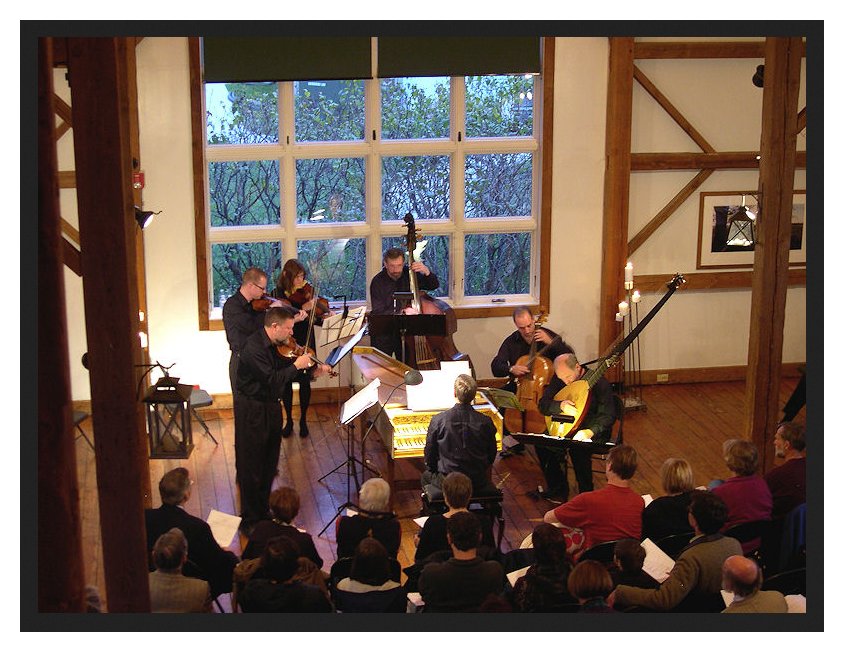
BD: Are there times
that you need two different instruments in a single concert?
JF: Yes, that’s
come up fairly often. As you know, I’m particularly interested in early
music, and when music on the first half is programmed from the Baroque period
and the second half is of the Classical era, one goes back and forth a little
bit.
BD: That must be
a terrible burden on you to bring both instruments.
JF: [Laughs]
Well, it just demands a larger automobile.
BD: It’s a lot
different than bringing an A and a B-flat clarinet.
JF: Right.
But it’s all worth it. It’s great fun.
* *
* * *
BD: What advice
do you have for younger bass players coming along?
JF: The world of
possibilities continues to expand for the double bass. It’s just phenomenal!
I was actually in attendance at the first International Double Bass Society
Convention in 1968, and there was a gathering of a total of about forty people
in Madison, Wisconsin. It was headed up by Gary Karr, and there were
some very notable bassists — Fred Batchelder from the Philadelphia Orchestra,
Warren Benfield from the Chicago Symphony, Richard Davis who was a very famous
jazz bass player and now professor at the University of Wisconsin, Knut Guettler
from Norway... Sort of the grandfathers, now, of the modern bass movement
were all there. It was really an ear- and eye-opening experience.
BD: Was there an
immediate camaraderie amongst all the bassists?
JF: Oh, absolutely.
It was people who had been pursuing the same goals for many years coming together
and finding that they had friends, unbeknownst to them, who had been pursuing
similar things for years.
BD: [With mock
horror] “My god! I’m not alone!”
JF: [Laughs]
Exactly. But I bring that up because here it is 1997, and very talented
player and teacher, Paul Ellison, who teaches at Rice University, recently
held the umpteenth bi-annual convention, and there were, I guess, a couple
of thousand double bassists all in Houston for that convention, pursuing
everything from avant-garde jazz to early music, orchestral music, solo literature,
everything.
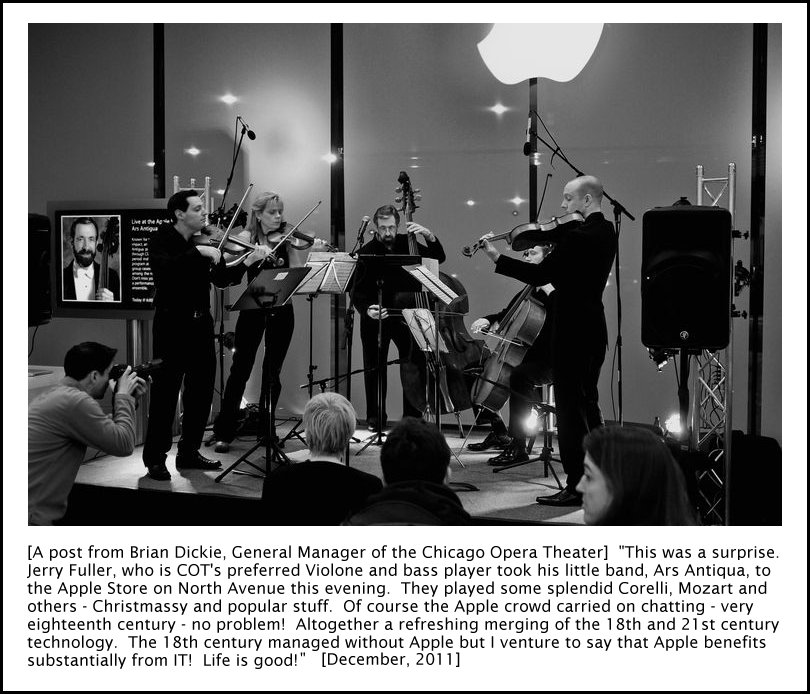
BD: Is it good
for someone to play both the old music and the new music, rather than specializing?
JF: There’s a lot
to be learned from both. I’m a strong advocate of doing both.
Having a historical perspective on performance techniques and styles gives
you greater flexibility, and you are more conscious of different possibilities
of articulation and approach no matter what style you are playing.
Similarly, a focus on some of the modern techniques and technical standards
is at a fairly high level. To bring that technical standard and excellence
to the early music is very beneficial, as well. So cross-pollination
is very helpful there.
BD: Do you do any
world premieres?
JF: I have.
BD: Is that satisfying?
JF: Oh, extremely.
As I mentioned, I was doing some work in Rome with William Ferris, and we
have had a very strong and good collaboration over the years. He has
written a number of chamber works and solo pieces for me, and I find working
with a composer like Bill opens another window into the creation of music.
Being part of actually birthing a piece is a very, very exciting thing to
do, and I would recommend that all musicians, all performers, seek out soul
mates who are composers and work with them because it really energizes both
the composer and the performer to work collaboratively and give birth to
something new.
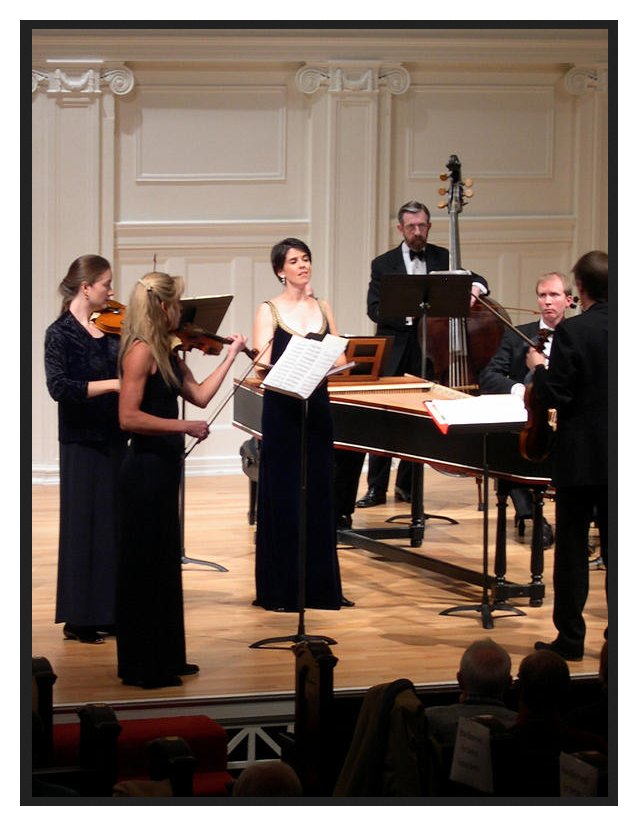 BD: What should a composer know about the double
bass that is generally not known, before he writes the piece? It can
be assumed that the composer would know a great deal about the violin or
the piano, probably having played it or studied it, but not the double bass.
BD: What should a composer know about the double
bass that is generally not known, before he writes the piece? It can
be assumed that the composer would know a great deal about the violin or
the piano, probably having played it or studied it, but not the double bass.
JF It’s interesting,
because I’ve worked with a number of composers where the balance and volume
levels of the instrument surprised them. It’s a huge instrument, as
you noted, to lug around or look at, and sometimes composers think that because
it’s physically big it has a huge penetrating sound, which is not the case.
It is a physically big instrument, but it has a very warm, sensuous, luscious,
mellow sound, rather than a penetrating, piercing sound. So the issue
of balance with an orchestral accompaniment, in terms of concerto, or even
with the piano in a sonata setting can be a surprise to composers.
BD: Do you put
the piano lid down rather than have the lid up?
JF: Oh, that’s
very interesting, because merely closing the lid on the piano does not solve
the problem. It changes the whole overtone series of the piano sound,
so it merely dampens and acts as a mute, rather than really addressing the
underlying issue of the relative volumes of both instruments. The real
answer is where the composer places the accompanying figures in terms of
register on the piano or other instruments, and what tone colors are used
in an orchestra. Then it’s a matter of simply
staying out of the way of the solo line of the double bass.
BD: Should the
accompaniment stay at middle C and above most of the time?
JF: Right, which
plays tricks on the listener’s ear, because we’re all conditioned to listen
to the top of the register for the melody. So when the melody appears
in the bottom of the range, of the pitch register, and the accompaniment
is above, it can be disconcerting for an audience’s ears that aren’t prepared
for that experience. But this links it all back into the 16th and 17th
century, because as you well know, one of the most popular forms of music
in that era was the madrigal. In those, there was rarely just one melody
on top and everything else was the accompaniment. Each part was its
own separate melody that fit together with the harmonic structure.
That’s one of the reasons why I’m so drawn to early music, because each voice
has its own melody, and that’s certainly true of the bass part as well.
BD: Having sung
many madrigals earlier in my life, they are wonderful!
JF: There you go.
Unfortunately, what occurred in the 19th century was that much beautiful,
wonderful repertoire was written for the orchestra in that era, but it tended
to relegate the double bass into an instrument of what I call punctuation,
rhythmic or harmonic punctuation, as opposed to true melody. It was
an era that did not exploit all the possibilities, as the earlier era did,
or many compositions today do.
BD: Are you pleased
that the repertoire for the bass is expanding again these days?
JF: Oh, absolutely!
There are so many composers doing so many fine compositions.
BD: When you get
a composition handed to you, how do you decide yes, you will spend the time
learning it, or no, you will set it aside or send it to some other bass player?
JF: That’s a tough
one. If at all possible, I try and tackle it myself, and I think I
have done that with every piece. Oftentimes there is a very personal
component to the relationship that I want to honor, as well. For example,
after the birth of our first son, Ken, there came a knock on the door, and
an envelope was dropped off. I opened it up, and there was a beautiful
lullaby for double bass and piano written by William Ferris. How could
I not work on that? How could I not play that? It was an absolutely
beautiful piece that, again, birthed another piece of art here.
BD: Let me turn
the question on its head a little bit. Is there any reason that someone
should write today for the older instruments?
JF: My answer is
absolutely, and the reason I say that is the older instruments represent
a whole spectrum of sound possibilities that simply can’t be exploited by
the instruments of today.
BD: More colors?
JF: Different colors.
One of my favorite authors is Stephen J. Gould, the anthropologist at Harvard.
One of his main theories is that the world is not necessarily always progressive,
and I feel that’s certainly true in the world of music. It is different.
What is being composed today is wonderful in its way. What was happening
in 1835 was wonderful in its way, and all the way back. But I certainly
do not ascribe to the belief that some hold, which is that what was happening
in the 18th century was a progression over what happened in the 17th, and
everything just marches in one forward direction.
BD: Yet the antithesis
of progression is not necessarily regression.
JF: Exactly!
That’s exactly correct. Each age has its own beauty, and the instruments
of the earlier times have a very special beauty which deserves to be explored
by people living now, both performers and composers.
* *
* * *
BD: You’ve played
in the bass section of a couple of orchestras. Is that also satisfying?
JF: Yes, in its
own way. It proved not to be ultimately satisfying for me, only because
I like to be very self-determined and creative, and develop my own visions
with the music. That’s why I love chamber music, particularly.
I can have a true strong voice, an impact on what the result is. Orchestras
that I’ve played with, both here and in Europe, have been marvelous experiences,
but I wanted more than that as well. I find the chamber music collaborations
probably the most satisfying.
BD: Let me ask
a real easy question. What’s the purpose of music?
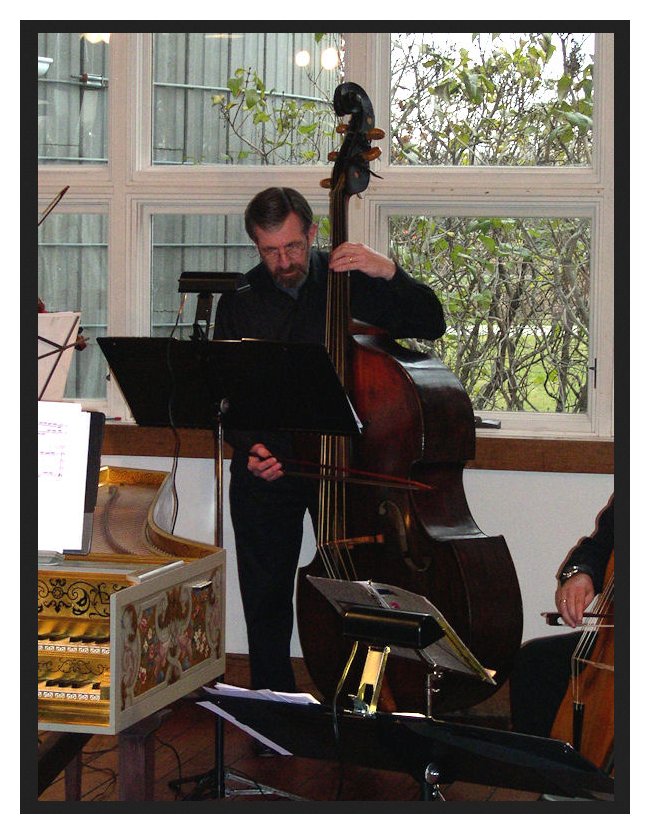 JF:
[Thinks for a moment] For me it’s multilayered, certainly. At
the top it’s physical, it’s sensuous, it’s in all of our senses, and it’s
aural. In fact one of the reasons I was really attracted to early music
is the feel of the gut strings under the hand, the mellowness and the sound
of it. So it’s satisfying in all of those dimensions, yet it connects
on another level, a deeper level. It connects me with other human beings
— not only those of us around today, but that humanity that has
always been there, that transcendent humanity of composers composing in another
place and another time.
JF:
[Thinks for a moment] For me it’s multilayered, certainly. At
the top it’s physical, it’s sensuous, it’s in all of our senses, and it’s
aural. In fact one of the reasons I was really attracted to early music
is the feel of the gut strings under the hand, the mellowness and the sound
of it. So it’s satisfying in all of those dimensions, yet it connects
on another level, a deeper level. It connects me with other human beings
— not only those of us around today, but that humanity that has
always been there, that transcendent humanity of composers composing in another
place and another time.
BD: Do you feel
connected to the old performers, too?
JF: I think so,
yes, especially because another part of early music that I find so attractive
and important is to work with the music, with the editions that were printed
in the time of the composers and the players of this early music, and to
see how they wrote down that music. Again, it’s another connection
to our humanness. Then, at its deepest level, it’s a very spiritual
activity for me. It has its religious aspects.
BD: We worship
at the altar of music?
JF: Yes.
BD: When you’re
playing the instrument, are you simply playing this piece of wood, or does
it actually become part of you so that it’s more your extension?
JF: I think of
it as an extension. Actually it’s like dancing with a wonderful woman
who’s a great dancer. It’s part of you. It is something different,
but it is part of you at the same time. There’s a lot of choreography
and dance-like aspects to playing the bass, so that’s another connection
to the maker of the bass who may have come from a different era, or the maker
today who’s making reproduction.
BD: Does your wife
ever get jealous of the instrument?
JF: [With a big
smile] Oh, I don’t think so. She started out as a musician herself,
a wonderful violist, so I think she understands.
BD: Do you ever
get to play together?
JF: Not anymore.
She has not played a viola for a long time, having given that up for three
marvelous children and a lot of computers. [Laughs]
BD: Now you can
have your own in-house quintet!
JF: Right.
There you go.
BD: Are you pleased
with where you are at this point in your career?
JF: Oh, there’s
always more that one wishes one could do and could have done. That’s
probably always going to be true. At the same time, I do have a certain
amount of satisfaction of having had the privilege to explore the music of
many different periods and many different places with very wonderful people
and great musicians. I feel very privileged for that, and in that sense,
it’s very satisfying.
BD: Does it take
a very special person to play the double bass?
JF: It’s not for
everyone. You can imagine someone drawn to the trumpet may not be drawn
to the double bass. In an orchestral setting, it’s an instrument where
you’re most noticed if you’re doing something wrong. [Both laugh]
BD: Piano subito is the time when the obscure
orchestral player becomes soloist.
JF: Yes, exactly,
and that’s one of the main reasons, ultimately, that orchestral playing wasn’t
for me, full-time. But that’s part of what a double bass does.
It is that blend and fitting into the whole, but still being extremely important,
although maybe not blatantly so. We’re a little
bit behind the scenes because the bass, so often, at least in an orchestral
setting, will set the harmony. It’s the harmonic anchor of everything
else that’s going on, and many times it’s the rhythmic
pulse of the entire ensemble as well.
BD: Most music
has the melody on top and the harmony on the bottom, and everything else
is fill.
JF: Yes.
[Laughs] So without the bass, everything would be truly lost.
But that point may not be always obvious.
*
* * *
*
BD: Do you play standing or sitting?
JF: I play standing.
I find that gives me the most freedom, physically, to move with the instrument.
But every bass player approaches that a little differently, and as we talked
about there are many approaches, many right approaches. There are some
marvelous bass players who sit, but my preference happens to be to stand.
BD:
When you come to a new concert venue, do you look for a good place to stick
that end pin?
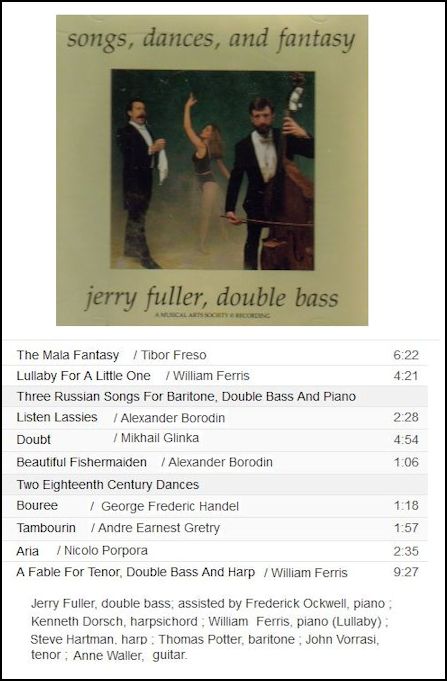
JF: [Laughs]
Oh, yes! Just finding a place sometimes can be a challenge, and it’s
always interesting. Some people are a little more fastidious than the
bass players about where they’ll allow this to happen.
BD: You don’t want
to put it in the middle of an expensive Oriental rug.
JF: Exactly, so
we need to be sensitive to our surroundings in many ways.
BD: Do you carry
a little coaster?
JF: Yes, and also
I have been known to remove my belt to put it around the end pin and fasten
it to my foot, so it won’t slip away from me in a slippery situation.
BD: I’ve seen bass
players moving their instrument on a little wheel.
JF: I’ve got a
little wheel for long walking trips between a concert hall and rehearsal
place. Sometimes that comes in really handy... another marvel of modern
technology! [Both laugh]
JF: You’ve made
three solo recordings. Do you play the same for the microphone as you
do for the audience?
JF: It is different.
I do find in a recording situation that it’s more difficult because there’s
not a real live audience there to react with. So for me, that’s a little
more difficult. I thrive on that interaction with audience, but both,
I think, are very important ways of performing. The discipline of recording
is extremely helpful for technique, and trying to get it on tape the way
you really want it. That’s always a challenge. The
whole world of recording a double bass is a very interesting study in science
in itself.
BD: Have you ever
thought of maybe putting a little screen or solid wood behind you, just to
focus the sound out?
JF: Actually that
works very well. What we found is that a lot of the sound of a double
bass actually emanates from the back of the instrument, that large, vibrating
back. So I really like to have a closer microphone near the F hole
of the instrument up and away in front of the instrument, and others three
or four or five feet in back of the instrument. This is another reason
why I like to stand rather than sit, so that the back can be completely free
to vibrate. I think it’s an interesting acoustical property of the
instrument.
BD: Are you pleased
with the records that have come out so far?
JF: Oh, you always
wish you could do things differently. So it’s the same idea as the
answer that I had before in terms of overall career. Certainly there
are things that I would like to do differently — better
— but I’ve come to say it chronicles me at that point in time
and space.
BD: I haven’t met
one musician yet that hasn’t said, “Oh, but it could be better!” [Laughs]
JF: Better, yes,
yes. It always can be better.
BD: Is there such
a thing as a perfect performance?
JF: I have never
achieved it.
BD: Does it exist?
JF: Boy, I’ve heard
some performances by others where it so moved me that I felt that came pretty
darn close, if not being there. But then it’s interesting... you go
backstage and talk to the performer, and they’re saying, “Oh, it could have
been so much better! I really wanted to do this...” [Both laugh]
So I guess it’s in the ear of the beholder whether that phenomenon truly
exists or not.
BD:
But in the end it’s all worth it.
JF: It’s all worth
it. No question.
BD: Thank you for
all the music that you’ve given us so far.
JF: Thank you very
much for keeping it all going. I appreciate that.
© 1997 Bruce Duffie
This conversation was recorded in Evanston, Illinois, on June 30,
1997. Portions were broadcast on WNIB six weeks later. This transcription
was made in 2016, and posted on this website at that time.
To see a full list (with links) of interviews which have been transcribed
and posted on this website,
click here. To
read my thoughts on editing these interviews for print, as well as a few
other interesting observations, click here.
* * * *
*
Award -
winning broadcaster Bruce
Duffie was with WNIB, Classical
97 in Chicago from 1975 until its
final moment as a classical station in February
of 2001. His interviews have also appeared in
various magazines and journals since 1980, and he now
continues his broadcast series on WNUR-FM, as
well as on Contemporary
Classical Internet Radio.
You are invited to visit his
website for more information
about his work, including selected transcripts
of other interviews, plus a full list of his
guests. He would also like to call your attention
to the photos and information about his grandfather,
who was a pioneer in the automotive field more than a century ago.
You may also send him E-Mail with comments,
questions and suggestions.
 Jerry Fuller began studying the double bass at age 16 and was invited to
join the Lyric Opera of Chicago orchestra three years later. Within two years
he was promoted to first desk of the double bass section in addition to performing
with the Santa Fe Opera. Mr Fuller has also served as solo double bass of
The Musikkollegium Winterthur Switzerland. While in Europe, Mr. Fuller became
interested in historically-informed performance practice and has achieved
international recognition for his work with period instruments. A Chicago
Artists Abroad grant recipient, Mr.Fuller’s performances in London, Rome,
Geneva and Edinburgh have been broadcast worldwide. In addition, Mr. Fuller
has performed at the Ravinia and the Aspen Music Festivals and both the Boston
and Berkeley Early Music Festivals.
Jerry Fuller began studying the double bass at age 16 and was invited to
join the Lyric Opera of Chicago orchestra three years later. Within two years
he was promoted to first desk of the double bass section in addition to performing
with the Santa Fe Opera. Mr Fuller has also served as solo double bass of
The Musikkollegium Winterthur Switzerland. While in Europe, Mr. Fuller became
interested in historically-informed performance practice and has achieved
international recognition for his work with period instruments. A Chicago
Artists Abroad grant recipient, Mr.Fuller’s performances in London, Rome,
Geneva and Edinburgh have been broadcast worldwide. In addition, Mr. Fuller
has performed at the Ravinia and the Aspen Music Festivals and both the Boston
and Berkeley Early Music Festivals. In the name of full disclosure, I am happy
to report that Jerry Fuller is a long-standing friend of mine... and it was
not until I just typed that sentence that I realized the phrase ‘long-standing’
also applies to his position with his chosen instruments! Indeed, we
talk about that later in the interview.
In the name of full disclosure, I am happy
to report that Jerry Fuller is a long-standing friend of mine... and it was
not until I just typed that sentence that I realized the phrase ‘long-standing’
also applies to his position with his chosen instruments! Indeed, we
talk about that later in the interview.




 BD
BD
